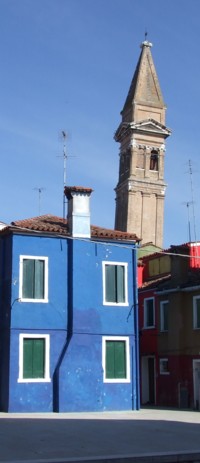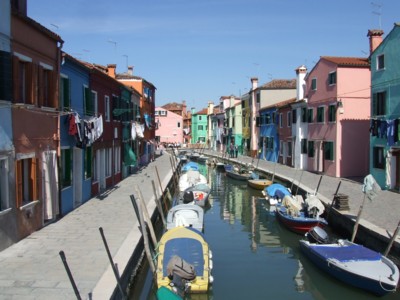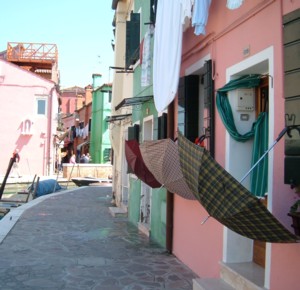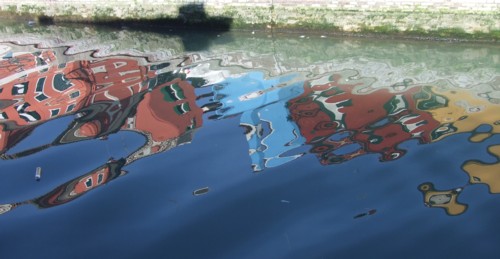Burano is a pretty island in the northern part of the Venetian lagoon. Famous for its lace-making and for its brightly-coloured fishermen’s houses, the island is a photographer’s paradise. A trip to Burano makes a great excursion or daytrip from Venice, when it can be combined with visits to the abandoned island of Torcello and its quiet neighbour Mazzorbo.
Exploring Burano provides countless photo opportunities. There are many charming yards and squares where drying laundry adds to the general decorative gaiety of Burano. Along the lagoon shore you’ll find superb views of neighbouring island Torcello (with, on a clear day, a mountainous backdrop) and smaller islands like San Francesco del Deserto (see below).

The town of Burano covers the island, with several small canals acting as thoroughfares. There are a couple of larger squares, and many little lanes and alleys. The town’s fishing industry can be glimpsed along the canalsides and around the island’s shores, where there are tiny fishing harbours. There are no essential tourist attractions other than the island itself and its general ambience. Apart from the painted houses, Burano’s most identifiable landmark is the island’s church, San Martino, which has an impressively-leaning belltower, to rival the most slanting of Venice’s campanili. Inside the church is a Cruxifixion by Tiepolo.
While Burano’s fishermen were out on the lagoon, their wives would traditionally sit outside their coloured houses making lace. The standard of Burano’s lace was very high, and the island became famous for its quality. The island’s lace-making museum (Museo del Merletto) is one of Venice’s civic museums and included in a joint ticket. Visitors can admire examples of lace made locally over the centuries, scrutinise photographic and written documentation and sometimes see lace-making in progress. You may also see women making lace outside some of the shops and houses, and every tourist shop is filled with lace handkerchiefs, doilies and clothes. The real article is very costly; the rest is cheap and imported.

The brightly-painted walls extend all through Burano, not merely along the principal tourist canals. We have no idea if householders are encouraged or even compelled to maintain their vivid colour schemes, or if it’s all genuine local taste. Guidebooks suggest the painting began with the fishermen’s desire to identify their own houses from the lagoon, which seems sweet but not particularly likely (the majority aren’t visible from the water in any case). Burano certainly seems to an outsider like a cheerful place to live. Open doors and laundry drying outside in the lanes adds to the impression of a friendly and tight-knit community.
Visitors don’t need to spend much time in Burano to see and photograph its main attraction: the colourful houses. But if you have longer to spend, it is also a nice place to enjoy lunch or wander around the quieter lanes. Although it is composed of the same components as Venice (houses, canals, bridges), Burano is very different in appearance and atmosphere and adds some variety to a Venetian holiday.

Eating in Burano
As well as a bar by the ferry stop, there are several other affordable places to eat in Burano. Wandering through the town’s main squares you’ll find a small range of cafes and restaurants.
Ristorante Riva Rosa
The best meal I’ve enjoyed on Burano was some years ago at a restaurant called Riva Rosa, which is on a picturesque corner of the town’s most picturesque canal. This is a smart and expensive restaurant, but a far cry from the over-priced tourist eateries you’ll find throughout Venice. The ambience is stylish and modern, and everything was of the highest quality. Tables arranged outside enjoyed blazing spring sunshine as well as the prettiest of views. Staff were friendly, obliging and spoke good English. The menu is composed largely of seafood dishes, but upon explaining that I didn’t eat fish, the waiter arranged for the chef to produce a special vegetarian dish for me. This was a lovely well-presented dish of spaghetti with a selection of vegetables including courgette, red pepper, aubergine, parsley (I thought) and plenty of oil. The meal tasted delicious, as did the bread and olive oil served previously. Other diners, indulging in the local lagoon and seafood dishes, seemed very happy with their meals and were testing out the wine-list. Prices were fairly high (although my vegetarian dish wasn’t extortionate), but the quality matched the expense.
Near Burano
Mazzorbo is an interesting detour, but most visitors to Burano set their sights first on famous, abandoned Torcello. Ferries (route T) run the short distance from Burano’s ferry stop to Torcello every half hour during the daytime – they use the same stop and have similar timetables to the longer-distance ferries so check that you are getting on the right boat. One of our friends ended up returning to Venice by mistake.
Over the water lies San Francesco del Deserto, a little island monastery. Archaeological remains on the island go back to the Roman era; the monastery dates to the thirteenth century. The monks (see website in the links panel on the right) will show you around between certain visiting hours (an offering is welcome). The difficulty is getting to the island. Visitors can try negotiating with Burano’s fishermen or water-taxi drivers.
Travel to Burano
If you’re starting your journey in Venice, the easiest way to get to Burano is to take the LN (Laguna Nord) ferry from the Fondamente Nuove stop on Venice’s northern shore (there are several different ferry stops so make sure you have the right one). The boat is bigger than the city’s normal vaporetti, and has a few seats outside. Normal Venice ACTV transport tickets are valid for the journey. Ferries run every half hour, and the journey time to Burano is 42 minutes. The island of Mazzorbo (the stop before Burano) is connected to Burano by a footbridge, so you can alight here if you wish to explore Mazzorbo first, then finish the journey on foot. A larger boat links Burano with the Lido, heading along the outer edge of the lagoon.
On this site
Useful external links
